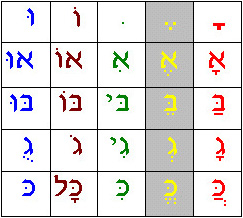U | O | Ee | Eh | A |

A, E, I, O, U.
2) Different from English, vowels make no sound unless they are related to a consonant.
To make the sounds A, E, I, O, U in Hebrew, there is a need to use the consonant Alef with each of those vowels.
3) Most vowel characters are positioned underneath the consonants.
4) There are more than five characters but for basic communication, however, remembering five of them is sufficient for now.
5) Like in English, not each consonant has a vowel. Many times the last consonant in a word does not have one. Not only at an end or beginning of a word, that is also true sometime for letters at the end or beginning of syllables.





















